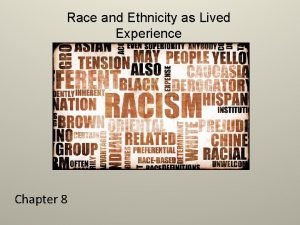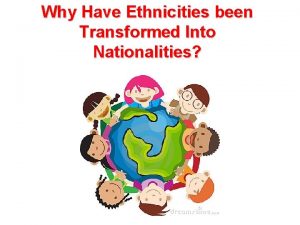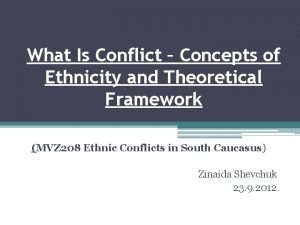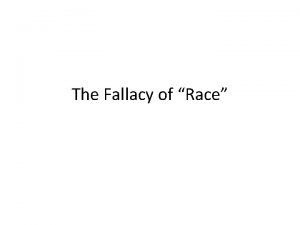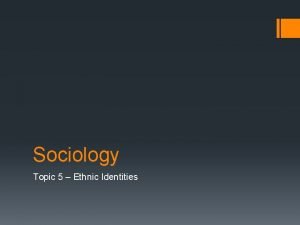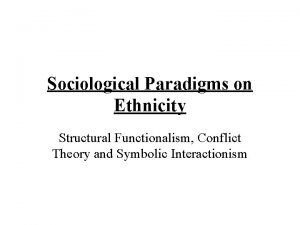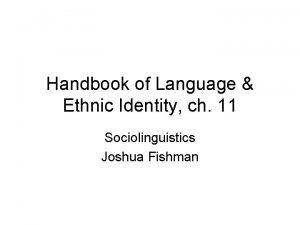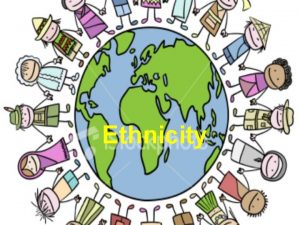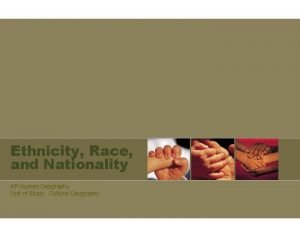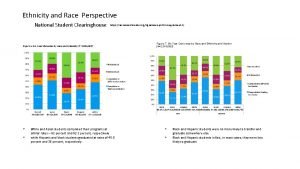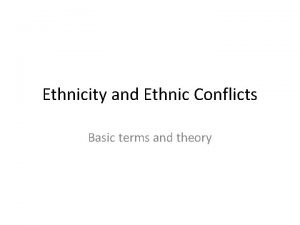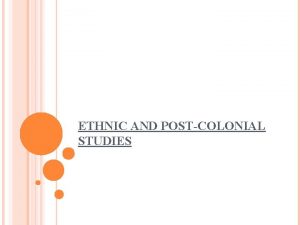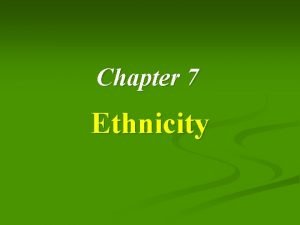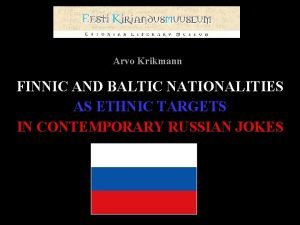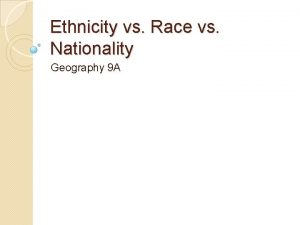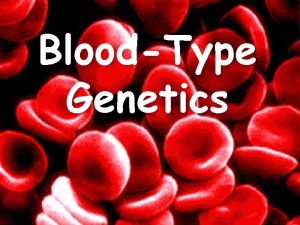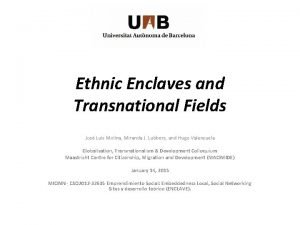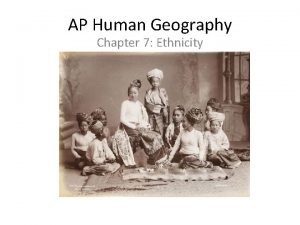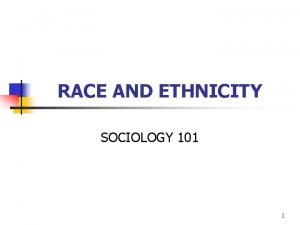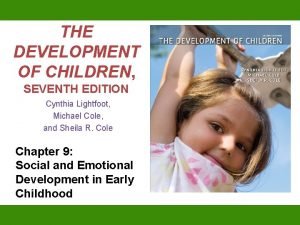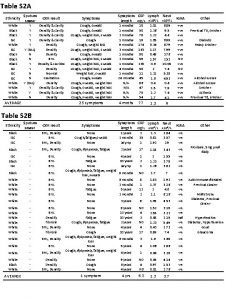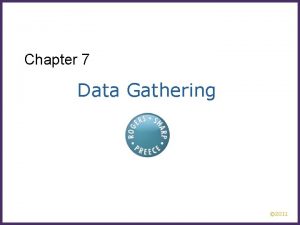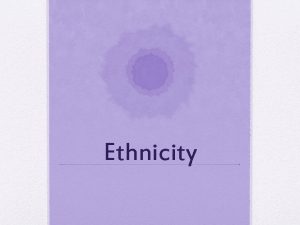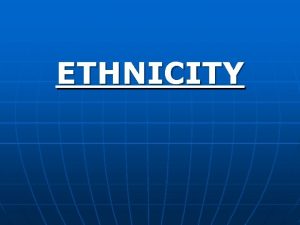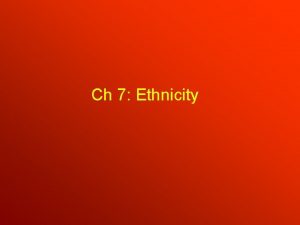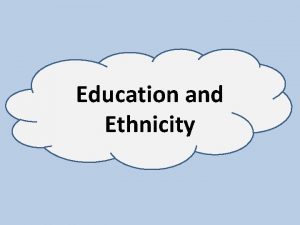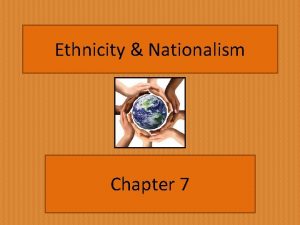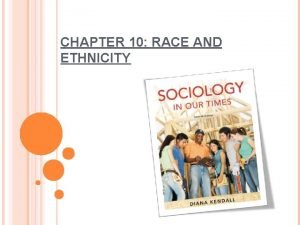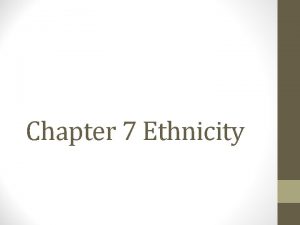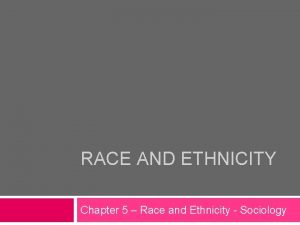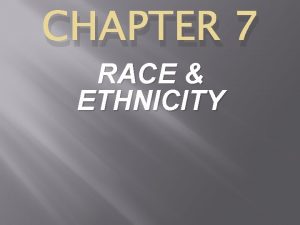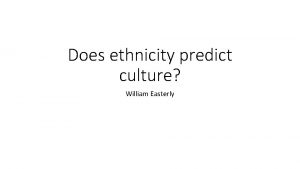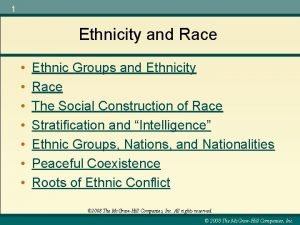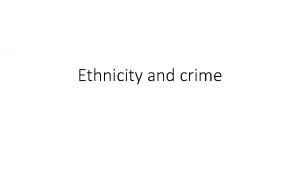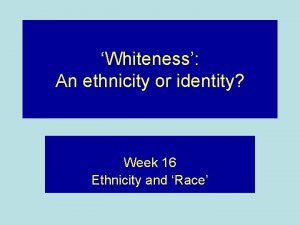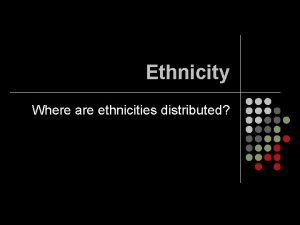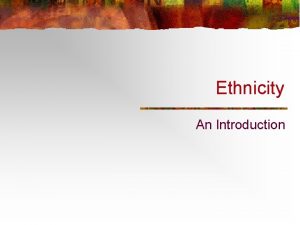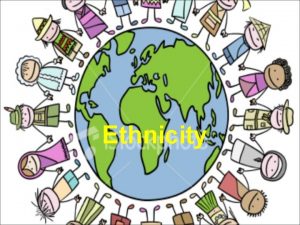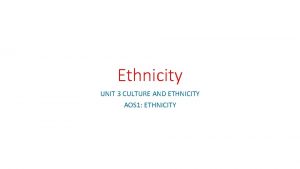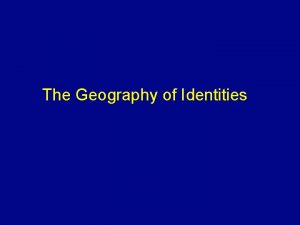Chapter 7 Ethnicity Ethnicity Key Issues Where are



































- Slides: 35

Chapter 7 Ethnicity

Ethnicity – Key Issues Where are ethnicities distributed? 2. Why have ethnicities been transformed into nationalities? 3. Why do ethnicities clash? 4. What is ethnic cleansing? 1.

Key Issue 1: Where are ethnicities distributed? Ethnicities in the United States ◦ Clustering of ethnicities ◦ African American migration patterns Differentiating ethnicity and race ◦ Race in the United States ◦ Division by race in South Africa

Race Race- Identity with a group of people descended from a common ancestor. Does not exist on a scientific level, despite influence of the idea. The truth is that there is very little fundamental genetic variety between humans and no way to tell where one category stops and another begins. ◦ Most of us are muts ◦ Race is literally skin deep. There has not been enough time for much genetic variation ◦ We do not have distinct “races” or “subspecies. ” ◦ http: //www. youtube. com/watch? v=VA 7 La 5 Jg. OUk

Race in the U. S. • Genetic Rosa Parks mixing is so common and complete that most geographers dismiss race as a category since it can not be clearly tied to place. Japan Town, San Francisco, 1910 Dogs Used to Control Protestors, 1957

What is ethnicity? Turkish Armenian Puerto Rican Ethnicity- Identity with a group of people that share distinct physical and mental traits as a product of common heredity and cultural traditions. ◦ Customs, cultural characteristics, language, common history, etc. . . The most common ethnicities within the U. S. are African Americans (Not Africans) and Hispanics/Latinos, about 13% each. ◦ Others include Asian American (4%) and American Indian (1%). ◦ Racial Shift: Mongolian Japanese Kazakh Thai Chinese

Clustering of Ethnicities Within a country, clustering of ethnicities may occur on a regional scale, or within particular neighborhoods of cities. Regional◦ In the U. S. , African Americans are clustered in the S. E. , ◦ Hispanics in the S. W. ◦ Asians in the West ◦ Native Americans in the S. W. and Great Plains. Why?

African Americans in the U. S. Fig. 7 -1: The highest percentages of African Americans are in the rural South and in northern cities.

Hispanic Americans in the U. S. Fig. 7 -2: The highest percentages of Hispanic Americans are in the southwest and in northern cities.

Asian Americans in the U. S. Fig. 7 -3: The highest percentages of Asian Americans are in Hawaii and California.

Native Americans in the U. S. Fig. 7 -4: The highest percentages of Native Americans are in parts of the plains, the southwest, and Alaska.

Clustering in Cities ◦ African Americans are highly clustered within cities, greater than 50% of blacks live within cities. Ex- In Detroit - comprise 80% of the pop, but only 7% of the pop in the rest of Michigan. The distribution of Hispanics in northern cities is similar to that of African Americans, for instance NYC is 25% Hispanic, but only 5% the rest of New York.

Clustering in Neighborhoods ◦ Especially visible on the neighborhood level in Chicago. Immigrants from S. and E. Europe tended to chain migrate to specific city blocks Likely to retain their ethnic identity through religion, food, and other cultural traditions rather than through location of residence.

Ethnicities in Chicago Jewish (Cohen) Fig. 7 -5: African Americans, Hispanic Americans, Asian Americans, and European Americans are clustered in different areas of the city.

Ethnicities in Los Angeles Fig. 7 -6: Hispanic, white, African American, and Asian areas in and around Los Angeles.

Clustering of African Americans ◦ ◦ ◦ The current clustering of African Americans w/in the U. S. results from three major migration flows: Immigration from Africa in the 18 th century (slave trade) Immigration from the South to northern cities during first ½ of 20 th century. Immigration from inner-city ghettos to other urban neighborhoods in the second ½ of the 20 th century.

Triangular Slave Trade and African Source Areas Fig. 7 -7: The British triangular slave trading system operated among Britain, Africa, and the Caribbean and North America.

African American Migration in the U. S. Fig. 7 -8: Twentieth-century African American migration within the U. S. consisted mainly of migration from the rural south to cities of the Northeast, Midwest, and West.

African Americans in Baltimore Fig. 7 -9: Areas with 90% African American population in Baltimore expanded from a core area northwest of downtown in the 1950 s.

Clustering of African Americans Blockbusting – second link ◦ process by which real estate agents convince white property owners to sell their houses at low prices because of fear that black families will soon move into the neighborhood. ◦ The real estate agents then turned around and sold the homes at extremely high prices to blacks that were emigrating from the inner city. Racism or stereotyping can lead to a phenomenon ◦ “White flight” is the rapid fleeing of whites from the cities as black families emigrate out of the ghettos, or as the ghetto expands. It was encouraged by blockbusting. ◦ Video ◦ Do you think this still happening today?

South African Apartheid ◦ Laws (no longer in effect) in South Africa that physically separated different races into different geographic areas. The apartheid laws were repealed in 1991 in South Africa, but many years will be needed to erase the legacy of such racist policies ◦ Nelson Mandela

Key Issue 2: Why have ethnicities been transformed into nationalities? Rise of nationalities ◦ Nation-states ◦ Nationalism Multinational states ◦ Former Soviet Union ◦ Russia ◦ Turmoil in the Caucasus Revival of ethnic identity ◦ Ethnicity and communism ◦ Rebirth of nationalism in Eastern Europe

Nationalism Nationality ◦ Identity with a group of people that show legal attachment and personal allegiance to a particular place as a result of being born there. Self-determination ◦ Concept that ethnicities have the right to govern themselves. Nationalism ◦ Loyalty and devotion to a particular nationality. ◦ WWI and WWII Songs

Nationalism As simple patriotism it helps create national unity When extreme ◦ It can be very dangerous to minorities ◦ Can breed intolerance of difference and Others Do we see examples in the U. S. today?

Nationalities and States State ◦ A politically organized territory that is administered by a sovereign government Nation-state ◦ A state whose territory corresponds to that occupied by a particular ethnicity that has been transformed into a nationality. Denmark Ethnic groups have been transformed into nationalities because desire for self-rule is a very important shared attitude for many of them

Centripetal & Centrifugal Forces Centripetal force ◦ An attitude that tends to unify people and enhance support for a state. ◦ 911 – patriotism ◦ Common enemy - Soviets, now who? Centrifugal force ◦ An attitude that tends to divide people and states. ◦ Ferguson ◦ Partisan politics

Multi-Ethnic and Multinational States Multi-Ethnic State ◦ State that contains more than one ethnicity. United States Multinational State ◦ State that contains two or more ethnic groups with traditions of self-determination that agree to coexist peacefully by recognizing each other as distinct nationalities. The United Kingdom & Soviet Union The Soviet Union was the largest multinational state until its fall in the early 1990 s; it consisted of 15 different republics based on its largest ethnicities. Now Russia is the largest multinational state, with 39 nationalities.

Republics of the Soviet Union Fig. 7 -11: The Soviet Union consisted of 15 republics that included the country’s largest ethnic groups. These all became independent countries in the early 1990 s.

Ethnic Groups in Russia Fig. 7 -12: Russia officially recognizes 39 ethnic groups, or nationalities, which are concentrated in western and southern portions of the country.

Key Issue 3: Why Do Ethnicities Clash? Ethnic Competition ◦ Horn of Africa ◦ Lebanon Dividing State to Dominate Nationality Ethnicities Among More than One ◦ South Asia ◦ Sri Lanka

Ethnic Division of South Asia At independence in 1947, British India was divided into India and Pakistan, resulting in the migration of 17 million people and many killings. In 1971, after a brutal civil war, East Pakistan became the country of Bangladesh.

Jammu and Kashmir India – Jammu & Kashmir Although its population is mainly Muslim, much of Jammu and Kashmir became part of India in 1947. India and Pakistan have fought two wars over the territory, and there has been a separatist insurgency in the area. Video

Sinhalese and Tamils in Sri Lanka The Sinhalese are mainly Buddhist and speak an Indo. European language, while the Tamils are mainly Hindu and speak a Dravidian language. http: //www. youtube. c om/watch? v=91 Za. Wcqy. PQ&feature=relate d

Key Issue 4: What is Ethnic Cleansing ◦ Bosnia ◦ Kosovo in Yugoslavia Ethnic Cleansing ◦ Rwanda in Central Africa

Key Issue 4: What is Ethnic Cleansing ◦ Ethnic Cleansing Process in which more powerful ethnic group forcibly removes a less powerful one in order to create an ethnically homogeneous region. Bosnia Rwanda Genocide
 Insidan region jh
Insidan region jh Chapter 8: race and ethnicity as lived experience
Chapter 8: race and ethnicity as lived experience Business model canvas key partner
Business model canvas key partner Key partners key activities key resources
Key partners key activities key resources Multiethnic state definition
Multiethnic state definition Concept of conflict
Concept of conflict Troian bellisario ethnicity
Troian bellisario ethnicity What is ethnicity
What is ethnicity Max weber social interactionism
Max weber social interactionism Symbolic ethnicity
Symbolic ethnicity Ethnicity in sociolinguistics
Ethnicity in sociolinguistics Lactose intolerance by country
Lactose intolerance by country Elements of nationalism include all but
Elements of nationalism include all but Ethnicity examples
Ethnicity examples What is ethnicity
What is ethnicity Ethnicity in postcolonial literature
Ethnicity in postcolonial literature Multiethnic state definition
Multiethnic state definition Estonian jokes about finns
Estonian jokes about finns Taylor swift blood type
Taylor swift blood type Porter novelli healthstyles survey
Porter novelli healthstyles survey Race vs ethnicity vs nationality
Race vs ethnicity vs nationality Blood type inheritence
Blood type inheritence Bitwit ethnicity
Bitwit ethnicity Is hispanic an ethnicity
Is hispanic an ethnicity Servingness
Servingness Louis molina ethnicity
Louis molina ethnicity Tower hamlets ethnicity
Tower hamlets ethnicity Ethnic conflict ap human geography
Ethnic conflict ap human geography What is cultural assimilation
What is cultural assimilation Power pointfy
Power pointfy Broad philtrum
Broad philtrum Gordon lightfoot ethnicity
Gordon lightfoot ethnicity Isc ethnicity
Isc ethnicity 5 key issues in data gathering
5 key issues in data gathering Five key issues of data gathering
Five key issues of data gathering Africa environmental issues worksheet
Africa environmental issues worksheet

